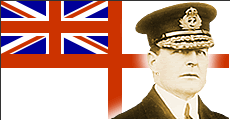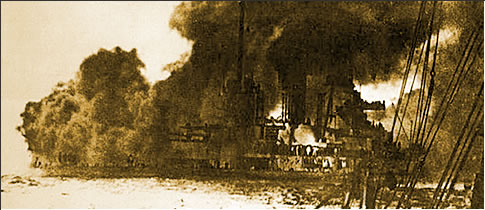The Battle of Jutland
Gains and Losses
The German ship SMS Seydlitz heavily damaged, flooded and on fire following the Battle of Jutland.
Ships Lost by Both Sides
As can be seen from the table below, the British lost more ships than the Germans, but the German High Seas Fleet had suffered more long term damage and importantly, Admiral Scheer’s plan of exterminating Beatty’s battecruisers had failed.
The British losses of major ships were sudden and spectacular, caused by the weakness of their defensive armour that allowed German shells to pierce the British ships magazine holds resulting in massive explosions.
 "There seems to be something wrong with our bloody ships today..."
"There seems to be something wrong with our bloody ships today..."
Admiral Sir David Beatty
Commander of the British Grand Fleet Battlecruisers
The British armour-piercing shells on the other hand, tended to explode outside the German ships defensive armour instead of actually penetrating and exploding within the body of the ship. As a result, some German ships with relatively light armour were able to survive direct hits.
 |
 |
 |
|
British Grand Fleet |
|
|
0 |
0 |
|
0 |
1 |
|
3 |
1 |
|
3 |
0 |
|
0 |
4 |
|
8 |
5 |
|
6,097 |
2,551 |
|
510 |
507 |
Despite the above figures, several surviving German ships were so badly damaged that they took months to repair. Admiral Jellicoe on the other hand, reported twenty four battleships ready for action the day following the battle.
German newspapers naturally claimed a glorious victory based on the numbers of ships sunk. It was significant, however, that the German High Seas Fleet did not put to sea again for the rest of World War I and the Royal Navy's British Grand Fleet continued to remain in command of the sea.

Navigation
+++ Background to the Battle +++
Why did the most powerful naval forces in the world collide at Jutland?
+++ The Admirals +++
Profiles of the commanders of the British and German fleets.
+++ A Comparison of the Fleets +++
A comparison of the strengths and weaknesses of the British Grand Fleet and the German High Seas Fleet.
+++ The Battle Area +++
Map illustrating the battle area of the Battle of Jutland, showing the positions of the British Grand Fleet and German High Seas Fleet at 14.00 hours on 31st May 1916.
+++ The Battle Action at Jutland +++
An animated movie of the Battlecruiser and Main Fleet action as the world's most powerful naval forces unexpectedly collide at Jutland.
+++ Gains and Losses +++
Damage assessment of the British and German fleets following the Battle of Jutland.
+++ Short Term Consequences +++
Quotes relating to the short term consequences of the Battle of Jutland.
+++ Long Term Consequences +++
Quotes relating to the longer term consequences of the Battle of Jutland.
+++ Free eBook: Battle Fleet Action from HMS Neptune +++
Join the look-out in the fore-top of HMS Neptune as Admiral Beatty's battlecruisers lead the German High Seas Fleet into the massed guns of the battleships of the British Grand Fleet.
+++ NEW! The Ultimate Battle of Jutland Resource Pack +++
This unique package is crammed with exclusive diagrams, images and rare hard-to-find resources that would take you weeks to find - even if you knew where to look.
+++ Image Gallery +++
A gallery of photographs displaying the ships and admirals of the British and German fleets that took part in the Battle of Jutland.
+++ Site Map +++
A list of every page on this web site.

 "There seems to be something wrong with our bloody ships today..."
"There seems to be something wrong with our bloody ships today..." 


